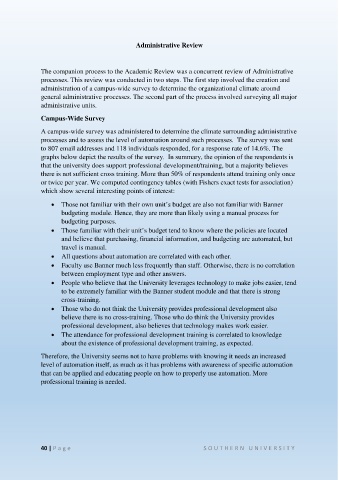Page 40 - Southern PPI Final Report-5 16 19
P. 40
Administrative Review
The companion process to the Academic Review was a concurrent review of Administrative
processes. This review was conducted in two steps. The first step involved the creation and
administration of a campus-wide survey to determine the organizational climate around
general administrative processes. The second part of the process involved surveying all major
administrative units.
Campus-Wide Survey
A campus-wide survey was administered to determine the climate surrounding administrative
processes and to assess the level of automation around such processes. The survey was sent
to 807 email addresses and 118 individuals responded, for a response rate of 14.6%. The
graphs below depict the results of the survey. In summary, the opinion of the respondents is
that the university does support professional development/training, but a majority believes
there is not sufficient cross training. More than 50% of respondents attend training only once
or twice per year. We computed contingency tables (with Fishers exact tests for association)
which show several interesting points of interest:
• Those not familiar with their own unit’s budget are also not familiar with Banner
budgeting module. Hence, they are more than likely using a manual process for
budgeting purposes.
• Those familiar with their unit’s budget tend to know where the policies are located
and believe that purchasing, financial information, and budgeting are automated, but
travel is manual.
• All questions about automation are correlated with each other.
• Faculty use Banner much less frequently than staff. Otherwise, there is no correlation
between employment type and other answers.
• People who believe that the University leverages technology to make jobs easier, tend
to be extremely familiar with the Banner student module and that there is strong
cross-training.
• Those who do not think the University provides professional development also
believe there is no cross-training. Those who do think the University provides
professional development, also believes that technology makes work easier.
• The attendance for professional development training is correlated to knowledge
about the existence of professional development training, as expected.
Therefore, the University seems not to have problems with knowing it needs an increased
level of automation itself, as much as it has problems with awareness of specific automation
that can be applied and educating people on how to properly use automation. More
professional training is needed.
40 | P a ge S O U T H E R N U N IVE R S IT Y

